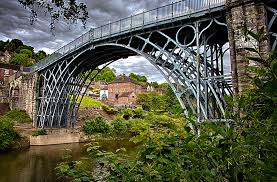We drive on them, we walk on them, we even ride our bikes over them, and yet as we pass them on our daily commute they fade into the scenery like so many oak trees. These valuable mechanisms have been around since the Mesopotamian society, and they provide the quickest means to get from one location to another in many places around the globe. Cities like Venice and Pittsburgh are famous for these structures. Without them, crossing a body of water would be impossible without a boat.
The structures I am referring to, of course, are bridges. Bridges can be made of numerous different materials; rope, wood, or stone, for example. In this entry, however, I am going to discuss some bridges with one things in common: iron.
It all started with an Englishman named Abraham Darby.
Abraham Darby
Cast iron was difficult to produce, and the charcoal needed made the material cost prohibitive. One day, Darby decided to try using coke (a byproduct of burning coal) instead, and an easy to produce, cost-efficient cast iron was born. Darby’s contribution did not end there, however. With economically feasible cast iron available, the architect Thomas Farnolls Pritchard decided that he would build a bridge across the Severns River, one of the most crowded rivers in England. Before he could see through the bridge’s construction, though, Pritchard died, and Darby’s grandson took over the project. The bridge, simply called Iron Bridge, was the first of its kind, drawing visitors from all over the world. Its great historical significance has protected it through the years, and today it is a UNESCO Heritage Site.
Darby’s Iron Bridge in England
Our next bridge takes us to Canada, to the home of Anne of Green Gables, Prince Edward Island (PEI). As you may or may not know, the soil in Prince Edward Island contains a unique variety of chemicals which produce world-class potatoes, different than any other potatoes available on the market. Their potato industry alone is worth a billion dollars annually.
Special potatoes from PEI
The special element in their soil? You guessed it: iron. The only problem was that all that connected PEI to the mainland of Canada was a ferry, which naturally was not extremely practical for shipping potatoes. The solution: a bridge of monumental proportions, the only one of its kind in the world, that would cross ice covered waters so that PEI would have a constant link to the mainland.
The Confederation Bridge, stretching from PEI to mainland Canada
This bridge is called the Confederation Bridge, and its primary material was steel. Which is composed mainly of (yes, you guessed it!) iron. The bridge was a massive success, and after its opening in 1997 potato production and shipment have increased dramatically.
The fact of the matter is, bridges get you where you want to go. Whether historical or modern, bridges can be analyzed by their chemical composition, the time in which they were built, or even by their reasons for being. Materials science, history, and anthropology go hand in hand, because each of them is present in nearly everything any society does. I look forward to bringing you future installments of this blog, because I really do think that this particular combination of fields is fascinating.
Thanks for reading and see you next time!




Nice article, I learnt a lot!
I can truly appreciate someone for taking their time to look at the history and the science of bridges. Like you said, I’m paraphrasing, without bridges many of the goods we use today would be gone, or a lot more expensive. Bridges connect people and ideas together and I’m glad you are trying to bring light upon this crucial keystone to modern transportation. I would’ve never thought about dating bridges based of materials so I’m really glad you brought that new idea to my. I really had a great time reading about them and I truss you had a great time writing it.
Good job Natalie! I can tell you’re really passionate about this stuff!
Olivia
I really liked your blog post, I have always found roads and bridges so fascinating because there are enough of them to get us wherever we need to go. I also liked learning about what they were made out off.